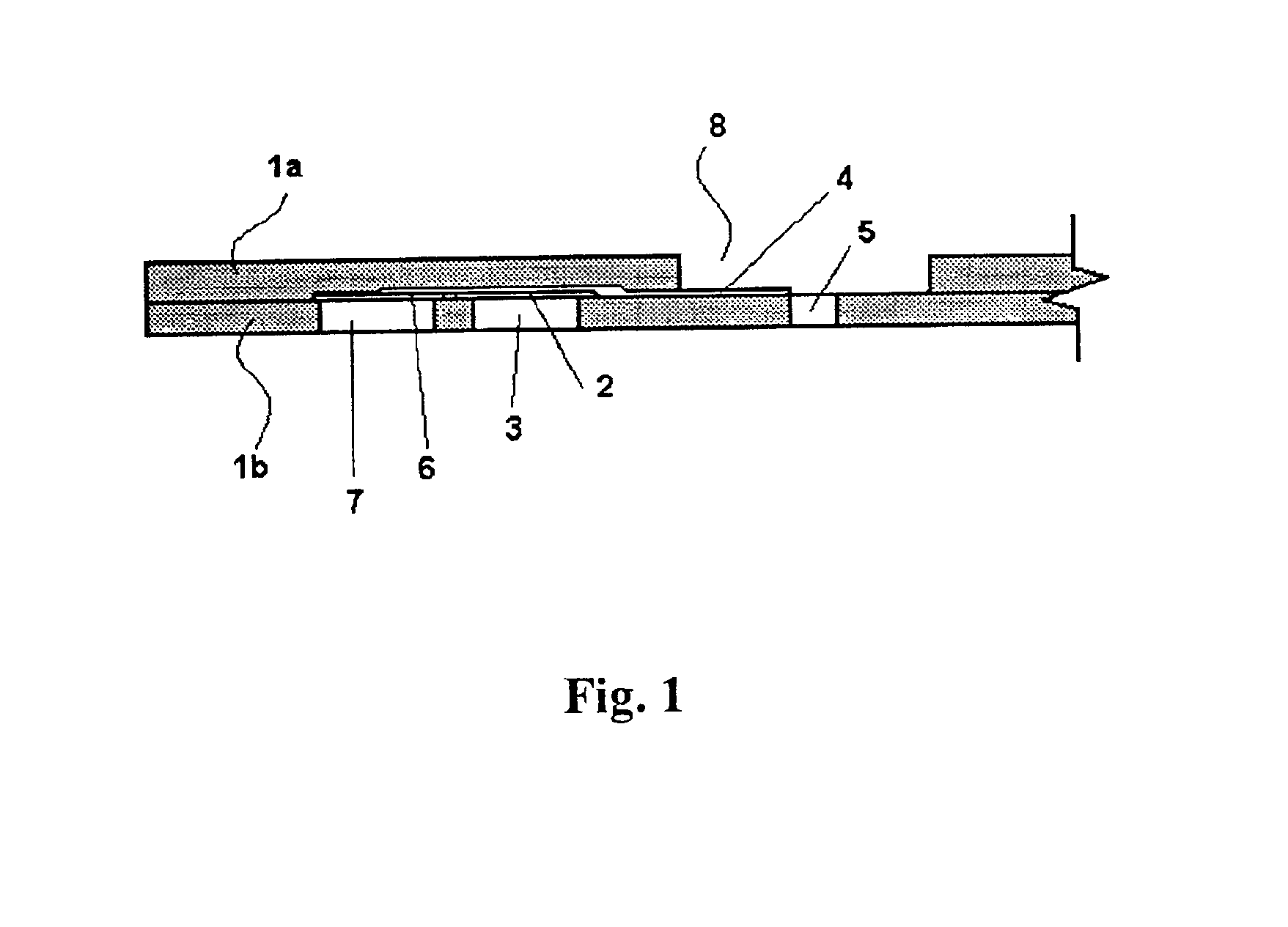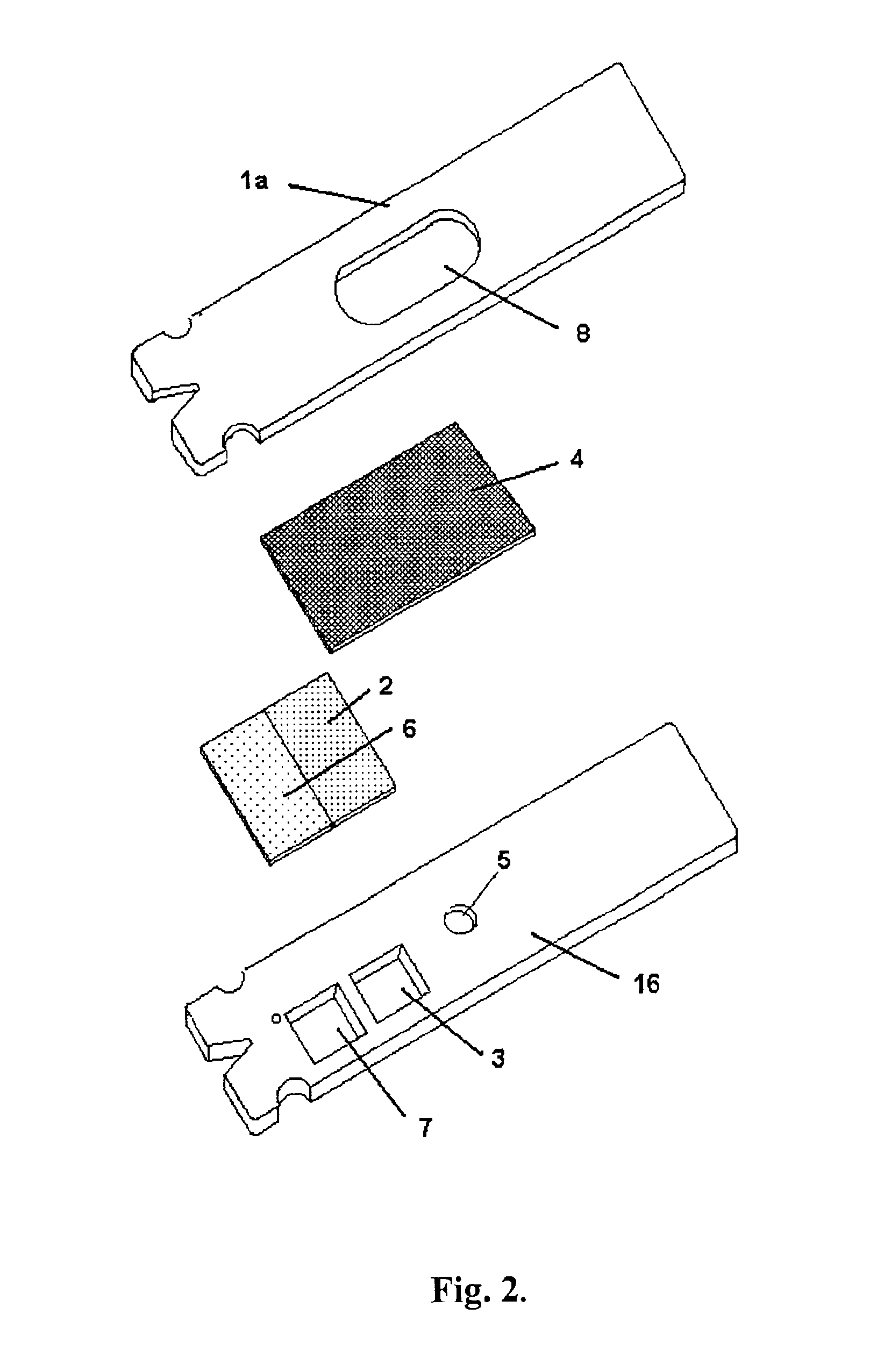Surface-modified wick for diagnostic test strip
a technology of surface modification and wick, applied in the field of wick and diagnostic, can solve the problems of no reading or improper reading of blood glucose monitor, and achieve the effects of reducing analysis time, improving accuracy, and finer analysis precision
- Summary
- Abstract
- Description
- Claims
- Application Information
AI Technical Summary
Benefits of technology
Problems solved by technology
Method used
Image
Examples
examples 1-5
[0029]The five fabrics listed in Table 1 were treated with an oxygen-methane glow discharge gas plasma as indicated above, and then were evaluated for wicking rate to whole blood using the arrangement shown in FIG. 4, with results shown in Table 2. A 20-microliter blood droplet size was used in the tests. Untreated wicking material candidates were used for controls to provide a basis of comparison, and are each listed as “Control” in the data in Table 2.
[0030]
TABLE 2ExampleWick TimeWick RateRatio toFabricNumbersec. / 2 mmmm / secControlBounce Lint FreeControl9.10.22n / aBounce Lint FreeExample 11.61.255.9Potentia ExsolControl4.70.43n / aPotentia ExsolExample 21.21.74.0Potentia Ivory (A)Control56.60.04n / aPotentia Ivory (A)Example 31.41.435.0Potentia Ivory (A2)Control5.80.35n / aPotentia Ivory (A2)Example 41.31.64.5Potentia Ivory (B)Control11.00.18n / aPotentia Ivory (B)Example 50.932.211.8
[0031]The data in Table 2 demonstrate that the examples exhibit wick rates of 1.3 to 2.2 mm / second, whereas ...
example 6
[0032]Bounce Lint Free was modified by oxygen / methane gas plasma treatment. Twelve reels of fabric 320 feet in length and 0.5 inch in width were modified. A sample from each reel was evaluated for wicking time with a blood droplet of 20 microliters, conducted as before. A sample of untreated fabric from the same lot was evaluated as a control. Table 3 lists the results of these evaluations. The reels of treated fabric exhibited an average blood wicking rate of 1.69 mm / sec, with a standard deviation of 0.20 mm / sec, whereas the untreated control exhibited a blood wicking rate of only 0.14 mm / sec, or about one-twelfth the rate of the treated reels.
[0033]
TABLE 3Treated FabricWick TimeWick RateReel Numbersec. / 2 mmmm / secControl14.50.1410.992.0221.081.8531.071.8741.161.7250.992.0261.081.8570.912.2081.002.0091.181.6910 1.311.5311 1.281.5712 1.181.69Average1.101.69Standard Deviation0.120.20
examples 7-10
[0034]Bounce Lint Free fabric was modified by methane / oxygen plasma treatment at plasma conditions of 5.75 seconds exposure time to an RF glow discharge plasma through a blend of oxygen and methane in a vacuum chamber at 400 mtorr pressure and 100 watts discharge power, wherein the oxygen / methane blend was maintained by addition of 17.4 sccm of oxygen and 11.6 sccm of methane to the gas plasma apparatus. Four lots of 12 reels of wicking fabric candidate were processed to assess the reproducibility of the treatment process and range of consequent wick rates. Swatches from these reels were tested for wicking rates by the same procedure used in examples 1-6. Results are shown in Table 4. The data in Table 4 show average wicking rates for the treated candidates in the range from 2.29 to 2.59 mm / sec, which are about 27 to 31 times greater than the untreated candidate.
PUM
 Login to View More
Login to View More Abstract
Description
Claims
Application Information
 Login to View More
Login to View More - R&D
- Intellectual Property
- Life Sciences
- Materials
- Tech Scout
- Unparalleled Data Quality
- Higher Quality Content
- 60% Fewer Hallucinations
Browse by: Latest US Patents, China's latest patents, Technical Efficacy Thesaurus, Application Domain, Technology Topic, Popular Technical Reports.
© 2025 PatSnap. All rights reserved.Legal|Privacy policy|Modern Slavery Act Transparency Statement|Sitemap|About US| Contact US: help@patsnap.com



